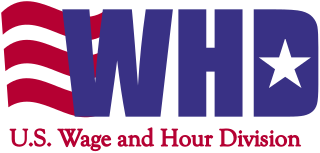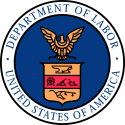Related Research Articles
Labour laws, labour code or employment laws are those that mediate the relationship between workers, employing entities, trade unions, and the government. Collective labour law relates to the tripartite relationship between employee, employer, and union.

The United States Department of Labor (DOL) is one of the executive departments of the U.S. federal government. It is responsible for the administration of federal laws governing occupational safety and health, wage and hour standards, unemployment benefits, reemployment services, and occasionally, economic statistics. It is headed by the secretary of labor, who reports directly to the president of the United States and is a member of the president's Cabinet.
Overtime is the amount of time someone works beyond normal working hours. The term is also used for the pay received for this time. Normal hours may be determined in several ways:

The Occupational Safety and Health Act of 1970 is a US labor law governing the federal law of occupational health and safety in the private sector and federal government in the United States. It was enacted by Congress in 1970 and was signed by President Richard Nixon on December 29, 1970. Its main goal is to ensure that employers provide employees with an environment free from recognized hazards, such as exposure to toxic chemicals, excessive noise levels, mechanical dangers, heat or cold stress, or unsanitary conditions. The Act created the Occupational Safety and Health Administration (OSHA) and the National Institute for Occupational Safety and Health (NIOSH).

The United States Women's Bureau (WB) is an agency of the United States government within the United States Department of Labor. The Women's Bureau works to create parity for women in the labor force by conducting research and policy analysis, to inform and promote policy change, and to increase public awareness and education.
The National Apprenticeship Act, is a federal law in the United States which regulates apprenticeship and on-the-job training programs.

In the United States, the minimum wage is set by U.S. labor law and a range of state and local laws. The first federal minimum wage was instituted in the National Industrial Recovery Act of 1933, signed into law by President Franklin D. Roosevelt, but later found to be unconstitutional. In 1938, the Fair Labor Standards Act established it at 25¢ an hour. Its purchasing power peaked in 1968, at $1.60 In 2009, it was increased to $7.25 per hour, and has not been increased since.
In United States government contracting, a prevailing wage is defined as the hourly wage, usual benefits and overtime, paid to the majority of workers, laborers, and mechanics within a particular area. This is usually the union wage.

The Oklahoma Department of Labor (ODOL) is an agency of the government of Oklahoma that is headed by the Oklahoma Labor Commissioner, a statewide elected position. ODOL is responsible for supervising the administration of all state laws relating to labor and workplace safety and gathers and publishes information about the workforce of Oklahoma.
The New York State Department of Labor is the department of the New York state government that enforces labor law and administers unemployment benefits.

The Fair Labor Standards Act of 1938 29 U.S.C. § 203 (FLSA) is a United States labor law that creates the right to a minimum wage, and "time-and-a-half" overtime pay when people work over forty hours a week. It also prohibits employment of minors in "oppressive child labor". It applies to employees engaged in interstate commerce or employed by an enterprise engaged in commerce or in the production of goods for commerce, unless the employer can claim an exemption from coverage. The Act was enacted by the 75th Congress and signed into law by President Franklin D. Roosevelt in 1938.

The Davis–Bacon Act of 1931 is a United States federal law that establishes the requirement for paying the local prevailing wages on public works projects for laborers and mechanics. It applies to "contractors and subcontractors performing on federally funded or assisted contracts in excess of $2,000 for the construction, alteration, or repair of public buildings or public works".

The Wage and Hour Division (WHD) of the United States Department of Labor is the federal office responsible for enforcing federal labor laws. The Division was formed with the enactment of the Fair Labor Standards Act of 1938. The Wage and Hour mission is to promote and achieve compliance with labor standards to protect and enhance the welfare of the Nation's workforce. WHD protects over 144 million workers in more than 9.8 million establishments throughout the United States and its territories. The Wage and Hour Division enforces over 13 laws, most notably the Fair Labor Standards Act and the Family Medical Leave Act. In FY18, WHD recovered $304,000,000 in back wages for over 240,000 workers and followed up FY19, with a record-breaking $322,000,000 for over 300,000 workers.

The Paycheck Fairness Act is a proposed United States labor law that would add procedural protections to the Equal Pay Act of 1963 and the Fair Labor Standards Act as part of an effort to address the gender pay gap in the United States. A Census Bureau report published in 2008 stated that women's median annual earnings were 77.5% of men's earnings. Recently this has narrowed, as by 2018, this was estimated to have decreased to women earning 80-85% of men's earnings. One study suggests that when the data is controlled for certain variables, the residual gap is around 5-7%; the same study concludes that the residual is because "hours of work in many occupations are worth more when given at particular moments and when the hours are more continuous. That is, in many occupations, earnings have a nonlinear relationship with respect to hours."

Wage theft is the failing to pay wages or provide employee benefits owed to an employee by contract or law. It can be conducted by employers in various ways, among them failing to pay overtime; violating minimum-wage laws; the misclassification of employees as independent contractors; illegal deductions in pay; forcing employees to work "off the clock", not paying annual leave or holiday entitlements, or simply not paying an employee at all.
The tipped wage is base wage paid to an employee in the United States who receives a substantial portion of their compensation from tips. According to a common labor law provision referred to as a "tip credit", the employee must earn at least the state's minimum wage when tips and wages are combined or the employer is required to increase the wage to fulfill that threshold. This ensures that all tipped employees earn at least the minimum wage: significantly more than the tipped minimum wage.

The Streamlining Claims Processing for Federal Contractor Employees Act was signed into law by President Barack Obama in 2013. It transfers some authority from the Government Accountability Office to the United States Department of Labor in order to streamline the implementation and enforcement of federal contractor wage laws. Previously, the United States Department of Labor was responsible for implementing the Davis–Bacon Act, "which requires that federally-contracted workers be paid the 'local prevailing wage' on government projects, and the Contract Work Hours and Safety Standards Act (CWHSSA), which mandates that federal contractors pay their employees overtime for hours worked in excess of 40 per week." Meanwhile, the Government Accountability Office was responsible for dealing with the claims of workers who did not make the correct wage. This law was designed to improve efficiency by transferring that responsibility to the Department of Labor.

Victoria Ann Lipnic is an American lawyer and public figure. She served in multiple senior United States government positions. She was Commissioner of the U.S. Equal Employment Opportunity Commission (EEOC), nominated to two terms by President Barack Obama, 2010 – 2020.) She served as Chair (Acting) of the EEOC under President Donald J. Trump from 2017 – 2019. Prior to her appointments to the EEOC, she was Assistant Secretary of Labor under President George W. Bush. The United States Senate confirmed her unanimously to each of these positions.

Keith E. Sonderling is an American lawyer and government official. He currently serves as a Commissioner on the Equal Employment Opportunity Commission, previously serving as Vice Chair. He was confirmed by the Senate on September 22, 2020. Prior to the EEOC, he served as the Acting and Deputy Administrator of the Wage and Hour Division of the United States Department of Labor. Before joining the government in 2017, he practiced Labor and Employment Law at the Florida-based Gunster Law Firm in West Palm Beach, Florida.
The Bureau of Labor Standards was an agency of the U.S. Department of Labor from 1934 until 1971. It was the direct predecessor of the Occupational Safety and Health Administration. The unit was formed as the Division of Labor Standards in November 1934, and renamed the Bureau of Labor Standards in 1948.
References
- ↑ "Employment Standards Administration". U.S. Department of Labor. Archived from the original on June 4, 2006. Retrieved June 8, 2006.
- ↑ "General Records of the Employment Standards Administration [ESA]". National Archives. 2016-08-15. Retrieved 2020-12-25.
- ↑ CCH (2009-11-08). "DOL confirms Shiu will be OFCCP Director". Hr.cch.com. Retrieved 2013-08-18.
- ↑ CCH (2009-11-08). "DOL's Employment Standards Administration to be eliminated - 09/24/09". Hr.cch.com. Retrieved 2013-08-18.
